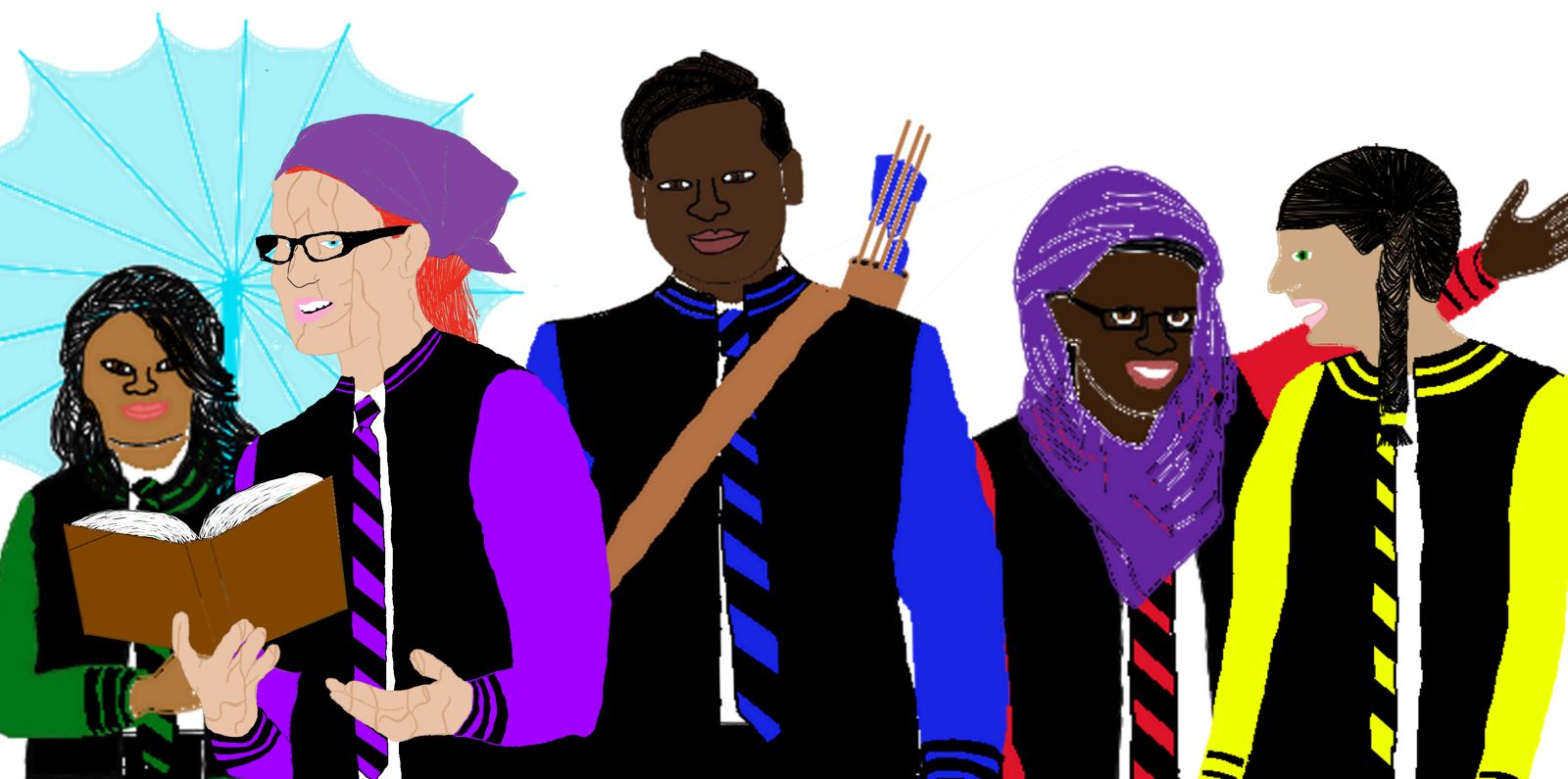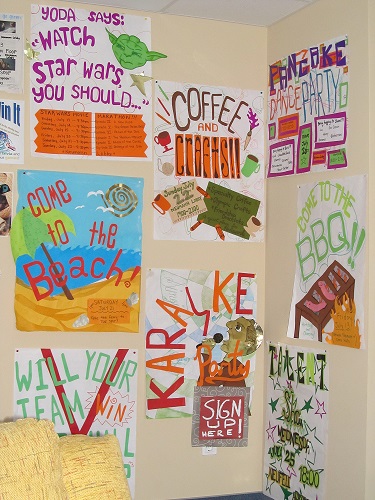Faraday School for Wizards
The most prestigious high school in Nideon
Faraday School for Wizards is a school in northern Nefrale for students ages fourteen to twenty-one, to earn a high school diploma with a specific emphasis on the study of Magic . It has become famous for its unique curriculum, and students from all over the world apply for a seat in their classrooms every year.
At the end of the first year, the first class of students at Faraday were asked to group themselves into teams. They were not required to create equal groups or have a certain element of diversity on their teams, as the founders hoped that the students on the teams would develop close relationships and did not want to interfere with this by forcing together students who did not naturally get along. Each of the five groups named themselves, as well as chose a color and an animal mascot to represent them. These groups became the five houses. The houses were never intended to represent specific traits or types of students, but because they have been left as much as possible in the hands of the students, they have each evolved "personalities."
Founding
Faraday was inspired by Copperridge University in Suxad and was intended to offer the same opportunity for magic study to high school students. Just as Copperridge University wanted to open this study up to anyone, regardless of background, Faraday was intended to do the same. Unlike Copperridge, Faraday did this by creating an exclusive admissions system in which the students with the most promise as wizards are admitted. The founders of Faraday also ascribed to a progressive teaching style which drove them to create an atmosphere in which students had a greater level of independence and responsibility. Though students generally have class from 7am to 4pm, there are no bells that dictate the start and end of each class. Rather, students are expected to arrive to class on time, and they are dismissed by the teacher when the class has ended. Furthermore, most students have a blank class period, during which they are generally left to their own devices. Another way in which Faraday tries to instill a greater sense of independence and responsibility into students is the practical manner of teaching which is accompanied by certain subjects. Not only are students able to take classes in which they learn how to sew or do woodworking, like in many high schools, but students can study transportation magic, using the small transportation station at the school to practice. Students interested in healing can work in the infirmary under professional healers and doctors, and students interested in cooking not only grow their own garden together, but they help prepare meals for the school.Houses
The house system of Faraday was another way for the founders to bring control to the students. Because Faraday has students from all over the world, it is a boarding school, with six dormitories, called houses. While one house, Victoria, specifically houses freshmen, the other five--Westwood, Providence, Hawthorne, Magnolia, and Liberty--are for older students. At the end of a student's first year, they are tapped for one of the other five houses, where they live the following three years. Victoria House has five student heads--one senior from each of the other houses--to help freshmen adjust to their new surroundings and to keep order in the house. The other houses each have two student heads--one male and one female--who perform the same job. In addition, each house has a staff head who assists the student heads and can bring a greater authority to serious matters. The five upperclassmen houses also have a house council in which any student from that house can participate, though only juniors are allowed to be officers, as they have the experience from the previous year, as well as invested interest in changes that will affect the house in the following year. Each house is given an annual budget, and the house council decides what to spend it on, or can choose to save for a later year. The house council also chooses which freshmen to tap at the end of the year. House councils have been known to agree upon other changes, such as when the council of Hawthorne House decided to abolish gendered dormitories. After debating the rules with the faculty, their demands were approved. Thus, unlike the other five houses, Hawthorne allows students of different genders to share rooms and does not require the house heads to be one male and one female, merely two students who are qualified to hold the position.The Founding of the Houses
At the end of the first year, the first class of students at Faraday were asked to group themselves into teams. They were not required to create equal groups or have a certain element of diversity on their teams, as the founders hoped that the students on the teams would develop close relationships and did not want to interfere with this by forcing together students who did not naturally get along. Each of the five groups named themselves, as well as chose a color and an animal mascot to represent them. These groups became the five houses. The houses were never intended to represent specific traits or types of students, but because they have been left as much as possible in the hands of the students, they have each evolved "personalities."
The Five Houses
- Westwood: Westwood House is known for athletes and healers. Their color is red and their mascot is the coyote.
- Magnolia: Magnolia House is known for diligent students who are often involved in social justice work. Their color is yellow and their mascot is the wasp.
- Liberty: Liberty House is known for tacticians and politicians. Their color is green and their mascot is the panther
- Providence: Providence House is known for rebls and innovators. Their color is purple and their mascot is the eagle.
- Hawthorne Hawthorne House is known for misfits and nonconformists. Their color is blue and their mascot is the platypus.
Diversity Versus Unity
As an international school, the staff of Faraday seek to celebrate diversity while also uniting the students under a common banner. Though they have houses which allow students who find kinship to come together, they also try to bring a sense of school unity. There is one major inter-house tournament in the spring of each year, which also allows students to practice the magic they have been learning. Outside of this event, houses are not pitted against each other, and Faraday students are encouraged to work together across house lines. Students are not scheduled based on house or year, they eat lunch together, and the school has sports teams which compete against other schools in the area. Students are also allowed to visit friends in other houses until the 10 o'clock curfew.Uniforms
The balance between diversity and unity is particularly noticeable in the Faraday uniform. All students are required to wear a Faraday school shirt--a white, collared shirt with the school starfish insignia on it, as well as a school tie. There are few restrictions, however, on the type of pants, skirts, or shoes they wear. Furthermore, students are allowed to add small cultural embellishments to their shirts, such as embroidery on the collar or different buttons. The school ties represent a students house--each being the house color with black stripes. Freshmen wear black and white striped ties. School jackets are also in house colors, and feature the house mascots, allowing students to show off their house pride. When students excel in a given area, such as a sport or fine art, they can earn a starfish patch for their jacket. This is known as "starring" in a skill. Despite the houses each having their own colors, the school colors are orange and white. Sports uniforms are white with orange lettering and orange trim. Furthermore, the school insignia itself is meant to be a representation of both the differences and unity of the students at the school. It is a starfish which is primarily orange, but has accents in the five house colors.Linguistic Diversity
While Shugbo is the language in which almost all classes at Faraday are taught, the founders of the school wanted merit to the be only factor in allowing students into the school. Students who are not fluent in Shugbo have the opportunity to obtain textbooks in several different languages, and can take Shugbo classes to help them improve their language skills. This is usually optional for students, but if teachers worry that a student is struggling due to a language barrier, they will test the student for language skills and create a more individualized program to help them succeed. Faraday also tries to maintain a linguistically diverse staff which has many major languages represented on it. Teachers who are multilingual sometimes teach language or literature courses in their other languages.Application Process
To apply for Faraday, a student must submit an application to the school within a given time window. Included in the application is a short essay by the student detailing why they show merit, as well as letters of recommendation. There is no application fee and applications are accepted in several different languages because the staff want to have as few barriers as possible for worthy students to apply and be accepted. Furthermore, for specific cases, adults who know students well, such as teachers may submit an application on a student's behalf. If an adult is recommending a student to the school, however, they must provide a good reason why the student is unable to submit the application themselves. The first wave of applications is split among faculty who weed out applications which they feel do not show enough merit. The remaining applications are submitted to an application board, consisting of a smaller group of teachers who review the applications together and determine who is accepted to the school.Scholarships and Funding
Admittance to Faraday is intended to be based on merit only. Having family who has been to the school before should not make it easier for students to be admitted, nor should a generous donation. On the flip side, while student tuition helps fund the school, students who cannot pay should not be prevented from attending. Faraday has budgeted scholarships based on need to help students who show strong merit but cannot afford tuition. Faraday is not only funded by tuition, but is partially subsidized by the Nefraelan government. Former students and wealthy benefactors also donate money to the school.
Posters for events in the Hawthorne House Commons
Type
School
Characters in Location




Comments